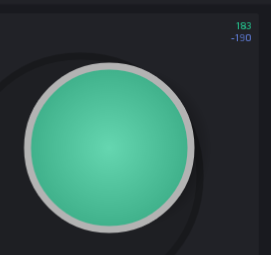Well as apparently as the unofficial “other user of this widget”  (I do use it for two different projects, a mobile rover and a Pan & Tilt for my PiCam) I should cast my vote… however I have no strong feelings either way.
(I do use it for two different projects, a mobile rover and a Pan & Tilt for my PiCam) I should cast my vote… however I have no strong feelings either way.
EDIT - OK, I re-read my post and I guess I do side on the “leave it as is” side after all  )
)
I can see both sides… Yes, it “just works” well enough as is 
But in order to use the corners with full X/Y values, it would need to be a “square”.
As is, one can extrapolate it out with math… but I belive it would also require a reduction in resolution to account for the truncated values in the current “corners”.
E.g. With a setting of -255 to 255 (leaving 0 as center) one can see how the round “corners” prevent reaching full 255 values for both axis… thus the device side math will have a reduced values to work with for extrapolation and more processing required for said math anyhow.

However… I feel that for most real IoT purposes, true corners and/or extrapolated resolution loss would be completely negligible, particularly for basic directional controls. I have found that anything requiring such motion precision probably shouldn’t be using a virtual interface anyhow as there is no tactile feedback required for such human interface precision.
I personally would prefer to see Blynk resources going to much more practical uses like a 4x20 LCD (OK, kidding… sorta  )… actually more like graphical customisation of buttons, sliders, gauges with user supplied imagery to complement the built in options. Including a true image viewing widget - pulling data from the device/server as needed. And so on. But that is for another topic
)… actually more like graphical customisation of buttons, sliders, gauges with user supplied imagery to complement the built in options. Including a true image viewing widget - pulling data from the device/server as needed. And so on. But that is for another topic 
PS, I haven’t bothered to sit down and measure it… but suspect that aside from the very fancy optically driven ones… even physical joysticks based on potentiometers will run into a small degree of “round” corners… these are analog devices based on physical limitations of rotation… not square touch pads 
Also, I suspect that most precision controls never expect to be driven to the stops in any axis.




 As “not a user” I try to keep away, but still have a “right to vote”. Well there is one important (?) reason to change it to “square mode”: Almost every widget in Blynk emulates real world control devices (yet I’m not aware of any Zergba remote control
As “not a user” I try to keep away, but still have a “right to vote”. Well there is one important (?) reason to change it to “square mode”: Almost every widget in Blynk emulates real world control devices (yet I’m not aware of any Zergba remote control 